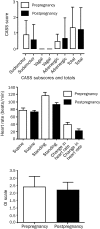Effect of pregnancy on postural tachycardia syndrome
- PMID: 20516426
- PMCID: PMC2894719
- DOI: 10.4065/mcp.2009.0672
Effect of pregnancy on postural tachycardia syndrome
Abstract
Objectives: To compare the clinical presentation, autonomic dysfunction, and pregnancy outcomes in parous and nulliparous women with postural tachycardia syndrome (POTS) and in women with POTS before and after pregnancy.
Patients and methods: This study consists of women who had at least 1 pregnancy during which time they met criteria for POTS between May 1993 and July 2009. All patients underwent standard autonomic testing. POTS was defined as a heart rate (HR) increase of greater than 30 beats/min on head-up tilt (HUT) with symptoms of orthostatic intolerance. Patients' charts were reviewed retrospectively to determine pregnancy outcomes.
Results: Clinical characteristics related to POTS did not differ between parous and nulliparous women except for disease duration (parous, 3.7+/-2.6; nulliparous, 2.1+/-2.2; P<.001). Autonomic dysfunction did not differ between groups (change in HR on HUT: parous, 42.6+/-12.0 beats/min; nulliparous, 41.3+/-10.6 beats/min; P=.39). Of 116 total pregnancies, adverse pregnancy outcomes were reported in 9% and maternal complications in 1%. No complication was related to POTS. There was a trend toward modest improvement in autonomic dysfunction before and after pregnancy (change in HR on HUT: before pregnancy, 38.1+/-22.7 beats/min; after pregnancy, 21.9+/-14.9 beats/min; P=.07).
Conclusion: The long-term impact of pregnancy on POTS does not appear to be clinically important. However, there does appear to be a trend toward improvement in the short-term postpartum period. Adverse pregnancy events were similar to those seen in the general public and do not present a barrier to women with POTS who want to have children.
Figures



Similar articles
-
A prospective, 1-year follow-up study of postural tachycardia syndrome.Mayo Clin Proc. 2012 Aug;87(8):746-52. doi: 10.1016/j.mayocp.2012.02.020. Epub 2012 Jul 15. Mayo Clin Proc. 2012. PMID: 22795533 Free PMC article.
-
Monitoring of cerebral oximetry in patients with postural orthostatic tachycardia syndrome.Europace. 2019 Oct 1;21(10):1575-1583. doi: 10.1093/europace/euz204. Europace. 2019. PMID: 31384930 Free PMC article.
-
Pregnancy in postural tachycardia syndrome: clinical course and maternal and fetal outcomes.J Matern Fetal Neonatal Med. 2012 Sep;25(9):1631-4. doi: 10.3109/14767058.2011.648671. Epub 2012 Jan 30. J Matern Fetal Neonatal Med. 2012. PMID: 22185354
-
[Postural orthostatic tachycardia syndrome (POTS)--pathophysiology, diagnostics, and treatment].Przegl Lek. 2014;71(8):450-3. Przegl Lek. 2014. PMID: 25546918 Review. Polish.
-
Postural tachycardia syndrome: a heterogeneous and multifactorial disorder.Mayo Clin Proc. 2012 Dec;87(12):1214-25. doi: 10.1016/j.mayocp.2012.08.013. Epub 2012 Nov 1. Mayo Clin Proc. 2012. PMID: 23122672 Free PMC article. Review.
Cited by
-
Symptoms of postural orthostatic tachycardia syndrome in pregnancy: a cross-sectional, community-based survey.BJOG. 2023 Aug;130(9):1120-1127. doi: 10.1111/1471-0528.17437. Epub 2023 Mar 12. BJOG. 2023. PMID: 36908200 Free PMC article.
-
Initial validation of symptom scores derived from the orthostatic discriminant and severity scale.Clin Auton Res. 2019 Feb;29(1):105-112. doi: 10.1007/s10286-018-0511-5. Epub 2018 Feb 28. Clin Auton Res. 2019. PMID: 29492828
-
Postural orthostatic tachycardia syndrome complicating pregnancy: a case report with review of literature.Obstet Med. 2012 Jun;5(2):83-5. doi: 10.1258/om.2011.110012. Epub 2012 Mar 29. Obstet Med. 2012. PMID: 27579141 Free PMC article.
-
Postural orthostatic tachycardia syndrome and orthostatic hypotension in post-acute sequelae of COVID-19 during pregnancy: a case report.Eur Heart J Case Rep. 2022 Nov 30;6(12):ytac453. doi: 10.1093/ehjcr/ytac453. eCollection 2022 Dec. Eur Heart J Case Rep. 2022. PMID: 36518330 Free PMC article.
-
Gynecologic disorders and menstrual cycle lightheadedness in postural tachycardia syndrome.Int J Gynaecol Obstet. 2012 Sep;118(3):242-6. doi: 10.1016/j.ijgo.2012.04.014. Epub 2012 Jun 20. Int J Gynaecol Obstet. 2012. PMID: 22721633 Free PMC article.
References
-
- Low PA, Opfer-Gehrking TL, Textor SC, et al. Comparison of the postural tachycardia syndrome (POTS) with orthostatic hypotension due to autonomic failure. J Auton Nerv Syst. 1994;50(2):181-188 - PubMed
-
- Thieben MJ, Sandroni P, Sletten DM, et al. Postural orthostatic tachycardia syndrome: the Mayo Clinic experience. Mayo Clin Proc. 2007;82(3):308-313 - PubMed
-
- Sandroni P, Opfer-Gehrking TL, McPhee BR, Low PA. Postural tachycardia syndrome: clinical features and follow-up study. Mayo Clin Proc. 1999;74(11):1106-1110 - PubMed
-
- Schondorf R, Low PA. Idiopathic postural orthostatic tachycardia syndrome: an attenuated form of acute pandysautonomia? Neurology 1993;43(1):132-137 - PubMed
-
- Jacob G, Costa F, Shannon JR, et al. The neuropathic postural tachycardia syndrome. N Engl J Med. 2000;343(14):1008-1014 - PubMed
Publication types
MeSH terms
Grants and funding
LinkOut - more resources
Full Text Sources
Medical
Miscellaneous

